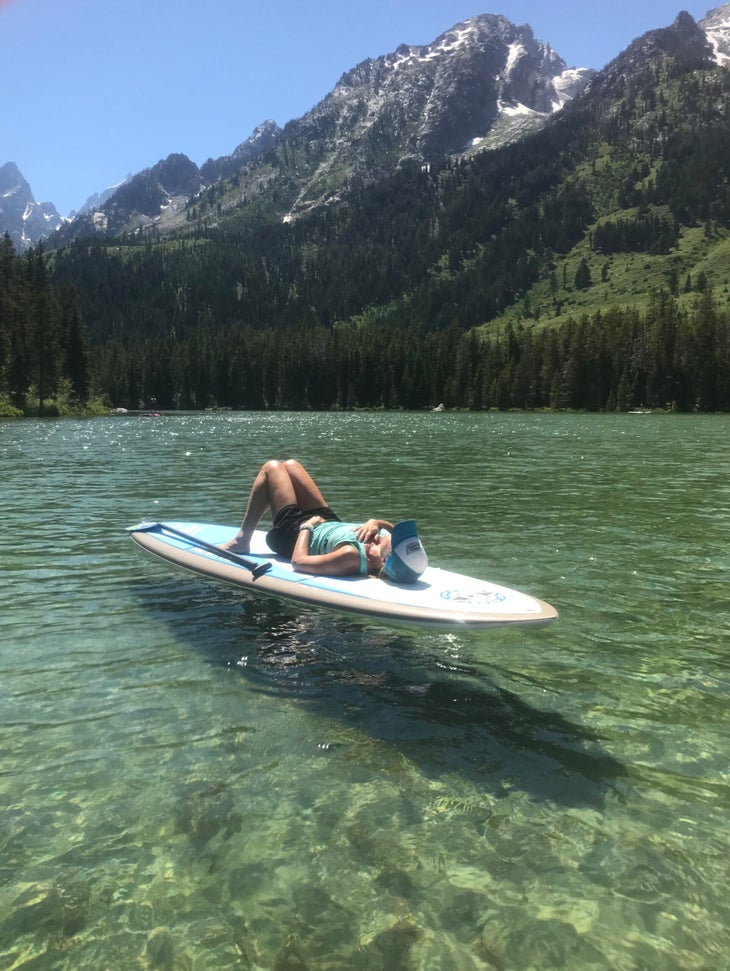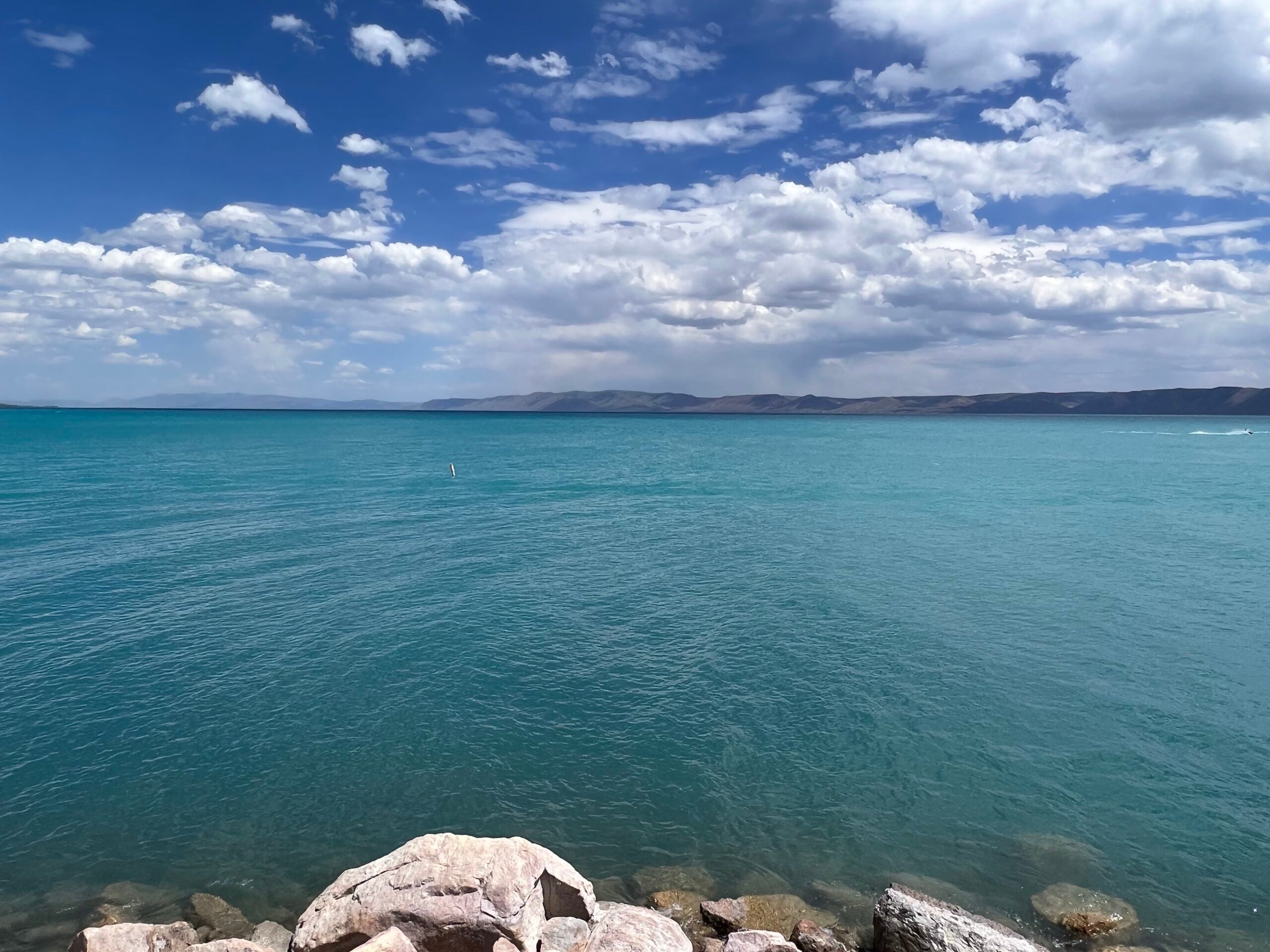I wasn’t introduced to the pleasures of lake life until my early 30s. Born and raised on the Jersey Shore, I was ocean obsessed. If the water didn’t have waves and leave me salt-kissed, I wasn’t interested. When I moved to Colorado 15 years ago, I was gripped by land-locked panic and started road-tripping to any body of water I could find. I soon discovered many of my favorite ocean sports (kitesurfing, paddleboarding, foiling) could be performed on lakes. And many of the lakes I visited were surrounded by wilderness trails that I could hike, bike, and run. Some shocked me with their Caribbean-esque beauty. Others awed me with their alpine backdrops.
While the jet-set flocks to Europe to see-and-be-seen on the glamorous shores of Lake Como, Italy, and Lake Lucerne, Switzerland, the adventure set heads to the U.S., where lake life is blissfully more rugged than refined. America is blessed with nearly 3 million lakes. Everyone knows Powell, Placid, and Tahoe (for good reason), so I won’t be redundant. And I’ll urge you to read Outside contributor Stephanie Pearson’s wonderful story on the overlooked playground of Lake Superior, which I have yet to visit. Based on my travels, these are nine lesser-known American lakes I highly recommend exploring this summer.
1. Bear Lake, Utah-Idaho Border
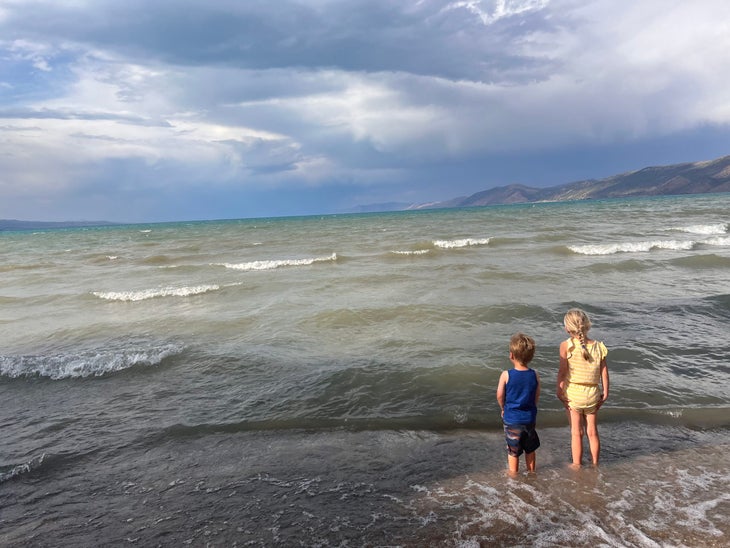
Why we love it: Bear Lake State Park’s sparkling jewel is nicknamed the “Caribbean of the Rockies” for its crystal-clear, turquoise waters, which owe their hue to an abundance of calcium carbonate deposits. At 20 miles long and 8 miles wide, the lake is almost perfectly split between Idaho and Utah. No longer a secret, its sandy shores can feel crowded in the peak of summer. But the Idaho Department of Parks and Recreation purchased an additional 28 acres of land last March, adding 1,200 feet of shoreline to the west of the lake to ease congestion.
Adventure intel: On my first visit to Bear Lake, I spent my days paddleboarding, kayaking, and wake surfing off popular Rendezvous Beach at the south end of the lake. Rental companies Bear Lake Fun and Epic Recreation stock every imaginable toy from Sea-Doos to water trampolines. Over the border, Epic Hot Springs’ ($20) two geothermal-heated pools are located right on North Beach and will warm you up after a windy day on the lake. Make time to explore beyond the shores. The surrounding area is home to fascinating caves, like Idaho’s Paris Ice Cave, which never completely melts, and fantastic hiking spots, like Logan Canyon, near Logan, UT.
Base: Conestoga Ranch lets you channel your Oregon Trail fantasies and overnight in retrofitted covered wagons that sleep up to six people (from $236). Located on the edges of the west side of the lake in Garden City, UT, one of the area’s main hubs, this Old West-inspired glamping resort has complimentary cruiser bikes, an onsite general store, and one of the best restaurants in town (they can also make picnics).
2. Cave Run Lake, Kentucky

Why we love it: Almost completely surrounded by the northernmost section of the Daniel Boone National Forest, this 8,270-acre lake is a mecca for anglers hunting muskellunge, known as the “fish of 10,000 casts” due to their elusive nature. It’s also a dream destination for boating, kayaking, sailing, and swimming and its shores are surrounded by hundreds of miles of hiking and biking trails.
Adventure intel: The town of Morehead is known as the Muskie Capital of the South. Hire Gregg Thomas at Battle the Beast guide service and try to hook a fish that tops the state record, just shy of 50 pounds. Tackle a stretch of the 300-mile Sheltowee Trace National Recreation Trail or trek the approximately six-mile out-and-back Buckskin Trail, which follows the shoreline and rewards hikers with an unbeatable view of Twin Knobs across the lake.
Base: On the south side of the lake, the Twin Knobs Campground has some 200 sites (from $31) spread out over 10 forested loops. Campers have access to a beach, volleyball courts, horseshoe pits, plus a boat ramp and fishing dock. The site also has easy access to scenic, low-key hikes, like the 2.5-mile Twin Knobs Shoreline Trail and the 1.5-mile Knob Overlook Trail.
3. Lake Ouachita, Arkansas
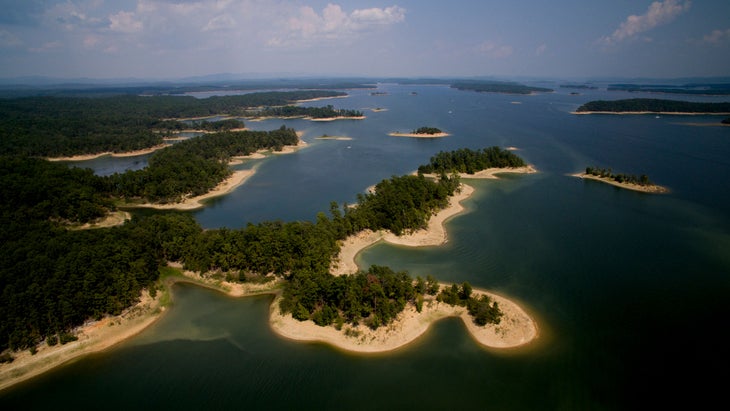
Why we love it: The refreshing lack of shoreline development around Arkansas’s largest lake makes it still feel wild and untouched; it also boasts some of the cleanest waters in the country. Surrounded by 1.8 million acres of forest and sprinkled with 200-plus islands, you can find a patch of wilderness all to yourself, even in the height of summer.
Adventure intel: Fishing outfitter Mad Dog Striper can help you hook whopper stripers and bass. This is also one of the few lakes that allows spear fishing. Lake Ouachita State Park hugs the eastern shores and its marina rents all the equipment you might desire. Kayak the 16-mile Geo-Float Trail. The first water-based interpretive trail included in the National Trails System features 12 exploration areas that shed light on the lake’s unique geological formations. You can also ogle many of these formations underwater while scuba diving the lake’s 30 dive spots.
Base: Lake Ouachita State Park has 93 campsites (from $16) and eight cabins (from $220), most overlooking the water. Or book a floating home from Dreamchaser Houseboat Rentals (from $3,000 for three days for up to 10 people).
4. Grand Lake, Colorado
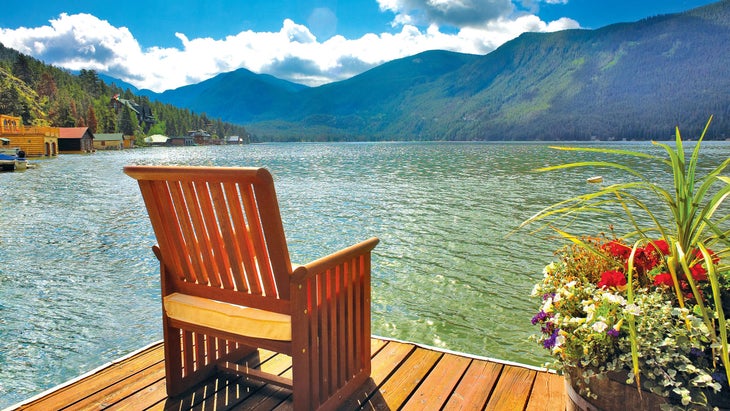
Why we love it: Originally called Spirit Lake by the Ute Tribe, Colorado’s largest and deepest body of water is a Front Range gem in summer with its public beach, yacht club, and marinas. Hemmed in on three sides by Rocky Mountain National Park, the area offers countless land-based adventures. And the tiny town of Grand Lake oozes old-timey nostalgia.
Adventure intel: Located steps from the historic downtown boardwalk, the Headwaters Marina rents pedal boats ($30 per hour), sports boats ($100 per hour), pontoons (from $140 per hour), and offers scenic, one-hour boat tours ($25). Family-operated Mountain Paddlers Kayak Shak is just in front of the marina and rents single and tandem kayaks (from $30 per hour). Rocky Mountain Park’s west entrance in Grand County is far less trafficked. The Adams Falls East Inlet Trail starts in town. It’s only .8 miles round-trip to reach the cascades. Continue another mile for awesome views of Mount Baldy and another 4.8 miles to reach Lone Pine Lake.
Base: Perched high above the water, Grand Lake Lodge has been welcoming guests since 1921. The cabins, originally purchased from the Sears Roebuck catalog, were recently renovated (from $185). It’s debatable which has the better sunset view: the porch swings or the hot tub and pool.
5. Green and Round Lakes, New York
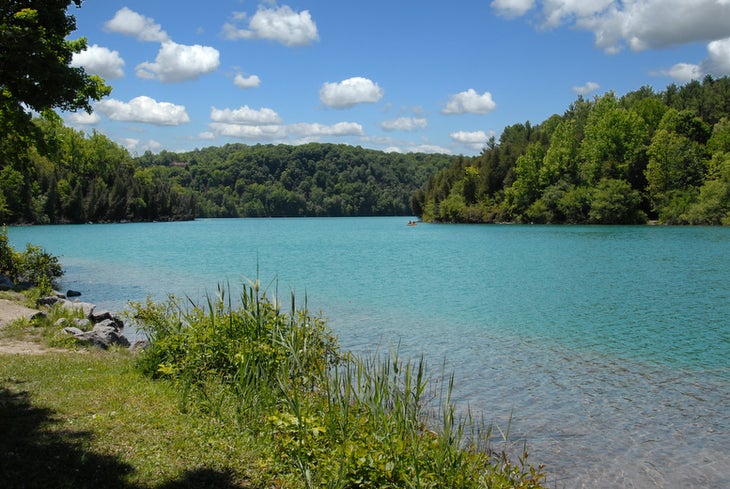
Why we love it: These two mesmerizing jade-colored bodies of water form the heart of 1,955-acre Green Lakes State Park, located 10 miles east of Syracuse. Aquatic anomalies, both are meromictic—a rare condition where surface and deeper waters do not mix—and contain calcium carbonate, which precipitates out of the water during late May to early June and settles to form white, reef-like structures on the shores. One of 28 National Natural Landmark sites in the U.S., Round Lake stands out for its border of old-growth forest (uncommon in the northeast).
Adventure intel: Green Lake, the larger of the two, has a sandy public beach with swimming access and a boat house that rents rowboats and kayaks (from $12 an hour). A network of 21 trails showcase the park’s old-growth forests and gorges; birdwatching fanatics can try to tick off 170 species.
Base: Green Lakes State Park Campgrounds has 137 campsites ($20-$39) and seven cabins ($115 per night, two-night minimum). Reservations can be made online up to nine months in advance; non New York residents must pay a $5 fee.
6. Lake Jocassee, South Carolina
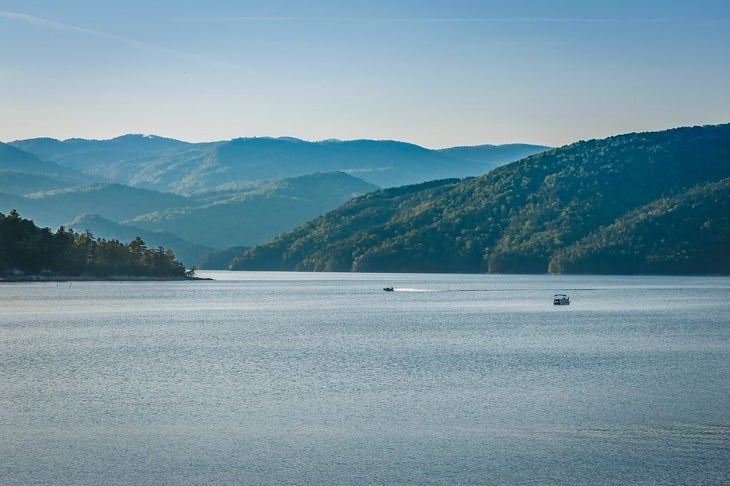
Why we love it: Nestled in the northwest corner of South Carolina, this fjord-like reservoir can only be accessed through Devils Fork State Park. Four Appalachian mountain rivers feed the lake, keeping its mirror-like waters remarkably clear and refreshingly cool. When I visited, I marveled at the solitude I found while angling for trout in a deep cove and paddleboarding past waterfalls that tumble into the lake.
Adventure intel: Located just outside of the park, Jocassee Outdoor Center is your one-stop-shop for groceries, boat rentals (from $400 for four hours), and wakeboards, tubes, and other water toys ($45 each). Jocassee Lake Tours rents single and tandem kayaks (from $50 per day) and also offers guided paddles to the best waterfalls ($125 for six hours). The park’s towering waterfalls—some of the highest in the eastern U.S.—steal the spotlight, but if you arrive in early spring, you might see pinkish-white Oconee Bells, one of America’s rarest wildflowers.
Base: The park operates 20 cozy, one- and two-bedroom “villas”—fully-furnished cabins with screened porches and waterfront views; all require a two-night minimum and some require a full week (from $275 per night). Campers can choose from 59 RV and tent sites, reserved online (from $32). For total seclusion, reserve one of the 25 sites in the park’s boat-in campground (from $40).
7. Lake McConaughy, Nebraska
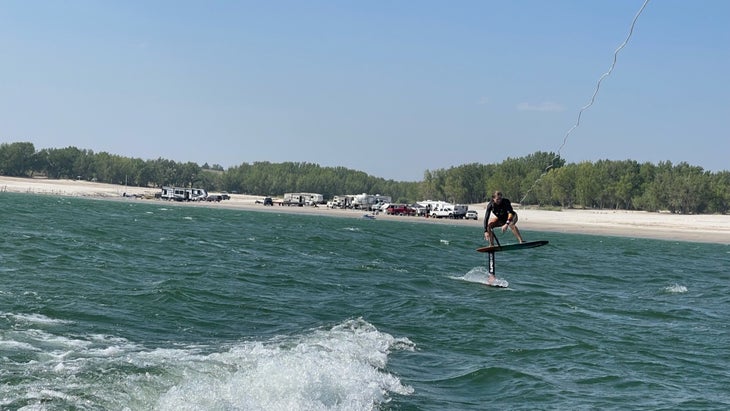
Why we love it: The azul waters of Lake Mac appear like a reverie amid Nebraska’s corn fields. If it weren’t for the John Deere tractors dotting the talcum shores, you’d think you were in the Turks & Caicos. The state’s largest reservoir, located within the Lake McConaughy State Recreation Area, is a 3.5-hour drive east of Denver. It’s one of my favorite summer “beach” escapes for camping on the sand, wake surfing, paddling, sailing, and kite surfing.
Adventure intel: The lake’s gateway town, Ogallala, is 20 minutes from the water. Make a pit-stop for supplies and a Nebraska-raised beef burger from excellent, locally-owned restaurant Driftwood. Ski Patrol rents ski boats and pontoons ($225 for two hours) as well as jet skis ($180 for two hours). Always Kayak offers rentals and instruction ($25 for two hours). Birdwatchers should bring their binos. The lake is home to some 170-plus species. Fishing enthusiasts descend here in July to compete in the Nebraska Walleye Trail Tournament.
Base: Camping reservations are required during peak season, May 20 through September 10. Non site-specific beach camping in 17 designated areas can be reserved 30 days in advance (from $20). Reservations for the five non-beach campgrounds can be made 180 days in advance (from $15). Last summer, I couldn’t score a site, but I was able to get a lakefront tent pitched ($33) on Admiral’s Cove’s two-mile stretch of private shoreline. The recently renovated resort also has RV hookups (from $40) and motel-style rooms and cabins (from $124), plus kayak rentals, a general store, and a great restaurant that regularly hosts live music.
8. Clear Lake, Oregon
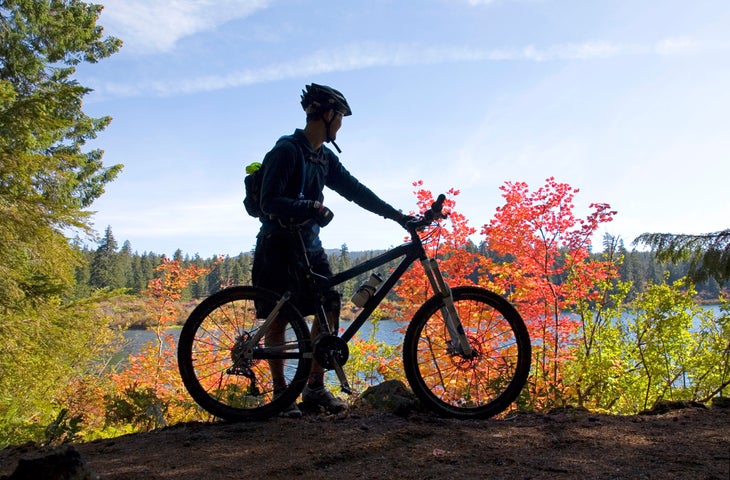
Why we love it: Boasting over 100 feet of underwater visibility, Clear Lake lives up to its name. This shimmering beauty was formed more than 3,000 years ago when a volcanic lava flow dammed the McKenzie River. A ghostly sunken forest lies beneath its cold, crystalline waters. Bounded by the Willamette National Forest, it’s a paradise for hiking and mountain biking.
Adventure intel: It’s of the best freshwater diving spots in the U.S. because it’s so clear and bottom-lined with ancient, petrified trees. Pack your 5 mill wetsuit (at least) as the water temperature averages 37 degrees Fahrenheit. You can rent gear and get intel at Salem Scuba or Central Oregon Diving in Bend. Get the lay of the land by hiking the 4.8-mile Clear Lake Loop Trail. The legendary McKenzie River National Recreation Trail is a must for mountain bikers, with 26 miles of singletrack winding through lava fields and old-growth forest along the eastern section of the lake. Horse Creek Lodge rents mountain bikes (from $55 per day) and offers shuttles ($35).
Base: The Coldwater Cove Campground on the eastern shore has 34 campsites, plus a boat ramp and fish cleaning station for anglers (from $33). On the lake’s north edge, Clear Water Resort has yurts (from $90) and cabins (from $80) and rents glass-bottom tandem kayaks ($25 per hour).
9. Lake Willoughby, Vermont
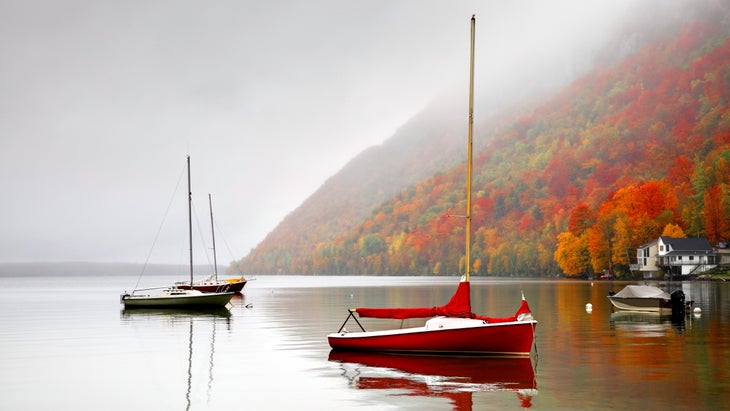
Why we love it: Sandwiched between the fjord-like peaks of Mounts Pisgah and Hor in the Northeast Kingdom, this glacial-carved lake is often referred to as America’s Lucerne. Its translucent waters stretch five miles long and one-mile wide, making it ideal for paddling, boating, and wild swimming.
Adventure intel: Earn your dunk after hiking the semi- strenuous, highly scenic 4.8-mile, out-and-back Mount Pisgah North Trail or biking the gravel trails of Willoughby State Forest. The lake’s calm waters are a pleasure to paddle (see equipment deets below).
Base: Mountain Lake Cottages is a little haven on the north shore (from $219). Ten log cabins each have two bedrooms, full kitchens, and porches (cabins 2-6 have the best lake views) and Clyde River Recreation delivers kayaks, paddleboards, and canoes right to the property (from $35 a day). On the south shores, Willoughby State Forest offers primitive camping. If you need amenities, White Caps Campground has RV Hook-Ups (from $52), tent sites (from $41), and cabins (from $81), equipment rentals, and a seriously good cafe that serves breakfast all day.
Jen Murphy is a regular Outside contributor and converted lake lover. She has plans to spend a week at Caspian Lake in Vermont this summer.
